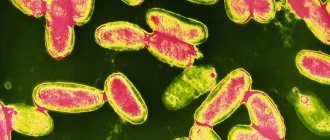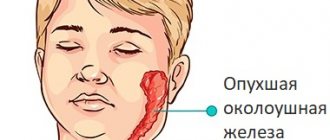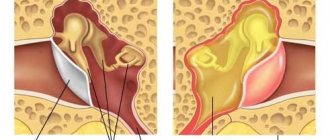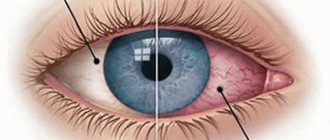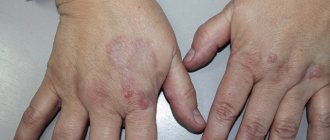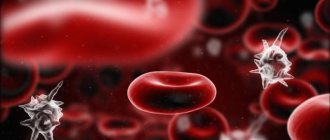Tracheitis is an inflammatory process in the upper respiratory tract with damage to the tracheal mucosa. The etiology of the disease can be viral or bacterial; it can occur as a result of various acute viral or bacterial infections or influenza. Tracheitis does not pose a threat to life if it is diagnosed in a timely manner and the necessary therapy is carried out.
The trachea is an air tube formed by cartilaginous half-rings between the bronchi and pharynx. Very rarely, tracheitis occurs as an independent disease; this can occur due to hypothermia of the body, inhalation of dry, hot or too cold air. In addition to a viral or bacterial nature, pathology can also occur as an allergic reaction to external irritants.
Classification by origin
Primary and secondary tracheitis
Primary tracheitis refers to a pathology that arose as a result of damage exclusively to the trachea. Other respiratory organs remain intact and cannot serve as a source of disease. Primary tracheitis is an independent disease, which is almost never characteristic of the acute form of the pathology.
Secondary tracheitis occurs against the background of other diseases of the upper respiratory tract of inflammatory or infectious nature. In addition to the trachea, the disease can cause secondary damage to the lungs, bronchi, sinuses, larynx, pharynx and other organs.
Infectious tracheitis
Viral type
Viral tracheitis is an acute form of the disease that occurs during acute respiratory viral infectious diseases and influenza. This type of pathology is very contagious and is usually transmitted by airborne droplets. Symptoms of this type of pathology always depend on the type of pathogen and the severity of the underlying infection. The most common symptoms are paroxysmal cough, which at the onset of the disease is unproductive, and as it resolves, it is accompanied by sputum that is discharged within several days, as well as acute rhinitis with rhinorrhea, copious mucous discharge from the nose and impaired nasal breathing.
Viral tracheitis does not usually need to be treated in any specific way. Usually, after the body produces antibodies against the incoming virus, the active phase of the disease passes. Therefore, in the normal course of a viral disease, it is enough for the patient to treat mucolytics with rest and warm drinks, and in the case of a paroxysmal dry cough, an antitussive drug can be taken to alleviate the symptom.
Bacterial type
Most often, the bacterial type of tracheitis occurs as a secondary infection after influenza or other acute respiratory viral infections, in which the causative agent can be any bacterial infection (Staphylococcus aureus, Streptococcus and Haemophilus influenzae). This type of tracheitis is not as contagious as viral tracheitis; it can be transmitted to a healthy person from a patient only in close contact. In terms of symptoms, bacterial tracheitis is practically no different from viral tracheitis, with the exception of the appearance of purulent sputum at a certain stage of the disease.
Fungal type
A rare type of tracheitis is a fungal type of disease. Most often, it can occur when the level of immunity is reduced when fungi of the Candida, aspergillosis or actinomycosis families are activated in the body. The disease of aspergillus etiology mainly simultaneously spreads to the mucous membranes of the bronchi and trachea, causing tracheobronchitis. With actinomycosis tracheitis, pathogens enter the tracheal zone from the esophagus, and candida penetrates the esophagus from the oral cavity, pharynx, and larynx.
Allergic type
Allergies can also lead to inflammatory processes in the mucous membrane of the trachea. In turn, allergic reactions can be the result of food allergies in children, hereditary predisposition, contact with various chemicals, long-term infections and other substances. Allergic tracheitis can occur in an acute form, or, with prolonged and constant contact with sensitizing substances, become chronic.
Diagnosis of tracheitis in children and adults
Examination of the patient is the most important point, without which it is impossible to prescribe adequate and effective therapy. Diagnosis is always carried out comprehensively and depends on the clinical picture of the disease, the patient’s age and the presence of certain chronic diseases.
Which doctor treats tracheitis?
The inflammatory process associated with the mucous membrane of the trachea is the competence of an ENT doctor or sometimes a pulmonologist. As a rule, the patient initially turns to a therapist/pediatrician and only then gets a consultation with a more specialized specialist.
Medical examination
First of all, the medical specialist who undertakes the treatment of the patient will ask him about the complaints and the timing of the onset of the first symptoms of tracheitis. Next, an external examination of the skin, lymph nodes and chest is carried out. The nature of nasal breathing is determined, whether there is congestion, swelling, or discharge. The condition of the throat is assessed (is there any redness, plaque, etc.). The doctor will definitely use a modern phonendoscope.
Laboratory tests and instrumental methods
Diagnosis, which is always carried out comprehensively, for tracheitis includes instrumental research methods, as well as laboratory tests. Initially, a general analysis is prescribed, in which blood is taken. It is considered standard for diseases of this kind. This test allows the doctor to detect an inflammatory process (if any) in the body of a person who has sought medical help.
Further, if tracheitis is suspected, a specialist may recommend undergoing radiography, which is most often performed in two projections. A photo of the front and side of the chest is needed. The results of such a study are a good opportunity to assess the condition of the entire bronchial tree and lungs, to exclude or identify various inflammatory processes.
Laryngotracheoscopy and tracheobronchoscopy are also not uncommon for tracheitis. These endoscopic diagnostic methods are common and successfully used in modern medicine. In the first option, the trachea and larynx are subject to examination, and in the second option, the trachea and bronchi are examined. The procedure is performed in an outpatient setting using a flexible endoscope that is inserted into the trachea.
The attending physician may also prescribe sputum examination and swabs from the nasal cavity and throat. Additional diagnostics for tracheitis include: allergy tests, rhino- and pharyngoscopy, as well as radiography of the sinuses.
Causes of the disease
Causative agents of pathology
The causes of tracheitis can be a variety of pathogens, as well as internal and external factors:
- bacterial microorganisms;
- viral infections;
- allergens of various types;
- work in hazardous production conditions;
- area with polluted air;
- hypothermia of the body;
- the presence of too dry or too humid air;
- complications of respiratory viral diseases.
In this case, the causative agents of viral tracheitis most often are:
- acute respiratory viral infections;
- parainfluenza, influenza;
- measles;
- rubella;
- scarlet fever;
- chicken pox.
The causative agents of bacterial tracheitis are most often:
- streptococcus;
- hemophilus influenzae;
- staphylococcus
Negative factors can also easily cause tracheitis. It often becomes a consequence of diseases that cause impaired nasal breathing, for example, rhinitis, sinusitis, adenoiditis, tumors and others. Tracheitis can be caused by diseases that lead to secondary immunodeficiency, many somatic diseases, as well as seasonal allergies, tobacco smoke and unfavorable environmental conditions (cold, dry and humid air, dust, etc.).
Psychological factors
The most important symptom of psychogenic tracheitis is a prolonged and painful cough. In order not to make a mistake and correctly identify a psychogenic cough, it is necessary to pay attention to the specific features of psychosomatic tracheitis:
- a strong cough during the day and its absence at night, emotional stress, unpleasant conversation, physical activity - all this can provoke a coughing attack;
- the cough lasts for a very long time and is not treated with any medications;
- During a medical examination, no disorders associated with the respiratory system are revealed, and there are no changes in the tests.
The human body tends to develop a defensive reaction to various actions or statements of others, and one of such reactions may be coughing.
Routes of infection
The contagiousness of tracheitis directly depends on the cause that provoked the disease. With the bacterial etiology of the disease, there is practically no chance of infecting a healthy person; this becomes possible only with very close contact with the patient, when bacteria can be transmitted by kissing or through shared utensils.
Viral tracheitis is very contagious and is easily transmitted by airborne droplets. For example, enterovirus or adenovirus are transmitted from person to person, even at a distance, provided they are in the same room. Talking, coughing and sneezing spread viruses into the air. Shared appliances are also excellent at spreading infection from person to person.
The contagiousness of the chronic form of tracheitis is determined by the stage of the disease. With stable remission and absence of relapses, transmission of the disease is impossible.
The most common route of infection is airborne tracheitis. When sneezing and coughing, viruses, the concentration of which in sputum is very high, spread into the environment and die in it. However, if a healthy person is nearby, particles of saliva or sputum enter the body with inhaled air and the person becomes ill.
Thus, infection by airborne droplets occurs when talking at short distances, sharing cutlery, sometimes shaking hands or sharing towels. The causative agents of tracheitis can cause not only this pathology, but also inflammation of all organs of the respiratory tract.
During the acute period of the disease, the patient is most contagious. At this time, it releases the maximum amount of pathogen into the environment. This period is characterized by the appearance of initial symptoms of the disease - sore throat, dry cough, general malaise. The acute period lasts up to 5 days. It is preceded by an incubation period, during which the patient is already infected, but the disease does not yet manifest itself. This period can last for tracheitis from 1 to 10 days. At this time, the sick person does not pose a danger to others.
Inhalations and cough rinses for tracheitis
It is best to treat tracheitis using local methods. Rinse and inhalation deliver medications directly to the site of infection. This helps prevent bacteria from spreading in the respiratory tract. Remember that inhalation is prohibited at elevated body temperatures.
Gargling
You can gargle with boiled water with soda and iodine or infusions of medicinal herbs.
For example, raspberry leaves help well. They need to be poured with boiling water in a thermos and left for 2 hours. Gargle three times a day. Chamomile infusion will help relieve inflammation of the trachea. Pour a glass of boiling water over a spoonful of herbs and leave for 1 hour. Gargle with warm broth several times a day. Calendula infusion kills germs and relieves pain; it is prepared in the same way.
Rinsing has an antibacterial and anti-inflammatory effect. The tracheal mucosa recovers faster from the disease if the procedure is performed 4-5 times a day. After it, it is advisable not to eat or drink for 1 hour.
Inhalations
Inhalations help get rid of bacteria and dry cough. They need to be done 1-2 times a day. It is best to purchase an inhaler at a pharmacy. If you don’t have one, you can use a kettle, bowl, or teapot with a hole in the lid.
Chronic tracheitis can be cured by inhalation with the following mixture:
- Sage,
- Anise oil,
- Eucalyptus leaves,
- Iodine,
- 2 drops of fir essential oil.
Mix the ingredients and pour boiling water. Breathe over the mixture for 5-7 minutes.
For wet coughs and to thin sputum, you can use tea tree oil. It is mixed with soda and dissolved in boiling water. Breathe for no longer than 7 minutes.
You can relieve inflammation using pine inhalation. For it they take pine or spruce needles. If you don't have them, you can replace them with essential oils. Natural pine needles must first be washed and boiled for 3 minutes. Breathe for 5-7 minutes.
Please note: the use of essential oils should not cause dizziness, nausea or other side effects. If they occur, stop using ethers. It is not recommended to give such inhalations to pregnant women and children under 12 years of age.
Symptoms of the disease
The main symptom of tracheitis is a paroxysmal cough. At the beginning of the disease, the cough is unproductive, then scanty sputum appears, at night and in the morning the intensity of attacks increases significantly, as with loud talking, laughing, crying, or taking a deep breath of air.
When coughing, the patient often feels a sore throat and pain or burning in the sternum. Gradually, the viscosity of sputum decreases and it begins to pass away more easily, which leads to a decrease in the cough itself and the pain it creates in the chest and throat. This may indicate resolution of the inflammatory process. Sometimes with tracheitis, inflammation can affect the mucous membrane of the larynx, which causes hoarseness. At the onset of the disease, an increase in body temperature and general weakness are most often observed. If, against the background of tracheitis, the bronchi begin to be affected and tracheobronchitis occurs, then the patient’s condition worsens and clinical symptoms of bronchitis appear - the temperature rises, the cough becomes more frequent and deeper, there may be shortness of breath and pain symptoms with each attack of cough, localized behind the sternum.
Warming treatments
Warming treatments help the body fight infection or viruses. They warm the throat and chest, expand the airways, and promote the removal of mucus. But they cannot be used at temperatures. Usually all compresses and rubbing are done at night, after which it is recommended to wrap the chest warmly and sleep under a blanket.
Honey is considered one of the most effective medicines. It is mixed with 3 drops of eucalyptus essential oil and rubbed into the chest. After this, you need to cover it with polyethylene and tie it with a warm scarf.
Boiled potatoes have a good warming effect. It needs to be kneaded and wrapped in gauze or cotton cloth. Apply the compress to your chest and hold until it cools down.
Another warming agent is mustard plasters. It is recommended to apply them to the chest or shoulder blades through gauze. Keep until cool. You can prepare the mustard mixture yourself from powder and boiling water.
Rubbing with animal fat - pork, badger, goose, bear - helps to heal quickly. It needs to be melted on the stove and rubbed on the chest, shoulder blades, and feet. After this, put on warm clothes and go to bed.
Compresses for the throat
Cough-relieving compresses on the throat can quickly cure colds and diseases of the upper respiratory tract. They are made from several layers of fabric with medicinal components. You can leave them overnight or do them during the day. The main thing is not to tighten the bandage too much.
A compress of alcohol or vodka has a warming effect. It is recommended to dilute pure alcohol with water in equal parts. Gauze is soaked in it, squeezed out and applied to the throat. You need to put a film on top for a warming effect. The third layer is cotton fabric.
A salt compress will help reduce swelling and relieve inflammation. It is best to use sea salt, but table salt will also work. It needs to be heated in a frying pan and poured into a fabric bag. It is applied to the throat and lies covered with a blanket until it cools down.
Nature of the disease
Acute form
Acute tracheitis occurs as a result of penetration of viral or bacterial infections into the tracheal mucosa. The disease occurs suddenly, and its duration is usually about 14 days. This form of the disease rarely occurs on its own; it mainly manifests itself as one of the symptoms of acute respiratory diseases and influenza.
The main cause of acute tracheitis is a viral infection; much less commonly, this pathology is caused by staphylococci, streptococci or influenza bacilli. A distinctive feature of acute tracheitis from other inflammatory diseases localized in the upper respiratory tract is a painful paroxysmal cough that prevents sleep at night, or starting in the early morning, often accompanied by chest pain. Periodically, coughing attacks begin with a small discharge of sputum.
Chronic form
Chronic tracheitis is a process of prolonged inflammation of the trachea. In this case, the chronic form of the disease is of two types - atrophic and hypertrophic. With atrophic chronic tracheitis, the mucous membranes of the trachea become thinner, while they acquire a gray tint and in places become covered with crusts, which in this case causes coughing. In the hypertrophic form of chronic tracheitis, on the contrary, the vessels thicken and the mucous membrane of the larynx swells, which also provokes cough syndrome.
The course of chronic tracheitis depends, first of all, on the state of the human immune system. If the body’s protective functions work as expected, then relapses occur rarely, mainly in the autumn. In the remission stage in adults, there are practically no symptoms of the disease. A slight cough without sputum may appear. In adults, symptoms of the chronic form of tracheitis during exacerbation may be more pronounced than during the initial acute stage. But more often the disease is tolerated much easier than when it first appeared.
Possible complications
Regardless of the form of the disease, against the background of the spread of the inflammatory process down the respiratory system, a whole group of complications is possible.
Tracheobronchitis is an inflammatory process that simultaneously affects the mucous membranes of both the bronchi and trachea. If tracheitis turns into pneumonia, then the general health condition sharply and significantly deteriorates, pain appears in the person’s chest during breathing and coughing. Ignoring the symptoms of the disease and failure to provide timely medical care can provoke laryngeal stenosis or obstruction of the bronchial tree. Bronchopulmonary complications are accompanied by high fever, severe cough, the appearance and rapid spread of pulmonary wheezing, and the development of hard breathing in the human lungs.
Treatment of illness during pregnancy
As soon as the first signs of tracheitis appear, pregnant women need to urgently consult a therapist. The infection easily penetrates the placenta to the fetus and causes various complications. The most common consequences are fetal hypoxia and termination of pregnancy.
If tracheitis occurs in a mild form, then limit yourself to antipyretic drugs and local antiseptics.
In severe cases, the safest antibiotics are selected:
- It is recommended to lie in bed throughout the entire period of illness.
- It is imperative to ventilate and humidify the air in the room.
- It is recommended to drink plenty of fluids, which will help remove phlegm faster.
- The diet should include more vegetables and fruits.
- Raspberry tea will help reduce the temperature.
- Onions can be used to make a syrup for oral administration or a paste for a compress.
- Inhalations with a decoction of chamomile, sage, and marigold are allowed.
- Gargling with a soda solution helps.
Any medicine, even a herbal one, should be selected only by a doctor, taking into account the peculiarities of the course of pregnancy and the general well-being of the expectant mother.
Duration of tracheitis
In adults, tracheitis most often occurs acutely and ends by 10-14 days. When suffering from the disease “on your feet” and self-medicating instead of adequate therapy, you can achieve chronicity of the inflammatory process and the addition of various complications, which will certainly affect the duration of the disease.
Protracted pathology will always be expressed by an increased cough and scanty sputum production. The attacks most often occur at night and can last up to 30 minutes each. When tracheitis is complicated by pneumonia or bronchitis, the duration of the disease can reach 1-2 months.
In children of different ages, tracheitis can last for different amounts of time. Schoolchildren usually get sick similarly to adult patients, and with inadequate therapy, their illness can drag on for 3-4 weeks. Preschoolers and infants have an incompetent immune system and a weak cough reflex, so the duration of the disease can last up to 4-5 weeks and occur with unexpressed symptoms - a slight cough with the release of a small amount of sputum.
How to cure tracheitis in a child
The basis of treatment for tracheitis in children are antibiotics and anti-inflammatory drugs. The most effective and safest antibacterial agent for them is Sumamed:
- based on azithromycin;
- Available in powder form, from which a suspension is prepared for children;
- has a wide spectrum of antimicrobial action;
- in otolaryngology it is used for diseases of the upper respiratory tract;
- for children it is used in a dosage of 10 mg per 1 kg of weight 1 time per day for 3 days;
- Contraindicated in case of impaired renal and liver function, sensitivity to macrolides, or concomitant use with ergotamine or dihydroergotamine.
The side effects of Sumamed should be studied in the instructions for this drug, because they are presented in a large list. The advantage of the medicine is the possibility of using powder from the age of one month, syrup from six months, tablets from 3 years. Inhalation solutions also help treat children from tracheitis. The drug Berodual is popular:
- contains fenoterol and ipratropium bromide;
- is available in the form of a solution for inhalation and an aerosol, which exhibit a bronchodilator effect;
- indicated for bronchial asthma, emphysema, chronic bronchitis, and other diseases of the respiratory tract with their reversible blockage.
Children over 6 years of age are advised to take 2 inhalations of Berodual aerosol up to 3 times a day. The solution is used for inhalation using a nebulizer. For the procedure, take 20-80 drops of Berodual per 3-4 ml of saline solution (for children over 12 years old). At the age of 6-12 years, the dose is 10-20 drops, less than 6 years - the amount of the drug is calculated based on the condition of 25 mcg of ipratropium and 50 mcg of fenoterol per 1 kg of weight. The advantage of Berodual is that it can be used from a very young age. Contraindications and side effects are numerous, so they should be clarified in the instructions for the drug.
Diagnosis of pathology
The diagnosis of tracheitis is made by a doctor based on several criteria. One of them is the patient’s complaints of paroxysmal non-productive night and morning cough, which over time becomes wet with scanty sputum and which greatly intensifies with a deep breath, crying, laughing, screaming. Also a sign of tracheitis for a doctor may be a complaint of chest pain when coughing. A history of the disease will demonstrate to the specialist the stages of development of the disease and help determine the cause of tracheitis. Physical examination of the patient includes in this case auscultation of the lungs for the presence of dry or moist rales, difficulty breathing, as well as laryngoscopic examination of the larynx.
Also, to diagnose and exclude complications, the patient must undergo a general blood test, which can indicate the viral or bacterial etiology of the disease. Among the additional diagnostic techniques for tracheitis, the following are common:
- X-ray of the lungs to exclude bronchitis or pneumonia;
- spirography or spirometry to assess the ventilation capacity of the lungs and the function of external respiration (this is necessary to exclude asthma or chronic bronchial obstruction);
- sputum analysis to identify the causative agent of the disease and determine its sensitivity to antibiotics if their use is necessary.
In some cases, with tracheitis, patients may be advised to consult a pulmonologist.
Possible complications
If tracheitis occurs as an independent disease, complications rarely occur:
- A common complication of laryngotracheitis is laryngeal stenosis.
- If the inflammatory process spreads to the lower respiratory tract, bronchitis or pneumonia may develop.
- Allergic tracheitis can cause bronchial asthma.
- Due to the constant inflammatory process, neoplasms may appear in the trachea.
If complications occur, the patient must undergo additional examination and treatment in a hospital setting, under the supervision of doctors.
Treatment methods for tracheitis
Traditional treatment of tracheitis is based on non-drug and drug treatment. Non-drug treatment includes establishing a rational drinking regimen with increased fluid intake in the form of teas, compotes, fruit drinks, heated alkaline mineral waters without gas, linden tea. The second mandatory condition is the patient’s complete cessation of smoking. It is also important to exclude those factors that can provoke coughing in each specific case, such as dust, smoke, etc. You need to eat well; food should be high in calories and enriched with vitamins. A variety of physical therapy procedures are recommended for patients with this pathology.
For drug therapy of viral tracheitis, there is no specific therapy, with the exception of the influenza virus, for which specific anti-influenza drugs are used. In the case of the bacterial nature of the pathology - antibiotics, often in inhalation forms, mucolytics to thin and facilitate the discharge of existing sputum, antitussives for painful dry coughs, inhalation of alkaline mineral waters to reduce inflammation and facilitate the discharge of sputum, antipyretics for body temperature above 38 degrees, immunomodulators to stimulate the immune system during frequent exacerbations of chronic tracheitis.
It is important to remember that the use of antibiotics in case of non-bacterial infection is fraught with the development of antibiotic-resistant pathogens of bacterial origin, which can pose a serious threat to people. Also, mucolytic drugs should not be used in combination with antitussives, since liquefied sputum in this case will begin to stagnate in the bronchi, which can cause the development of pneumonia.
Drug treatment
Treatment of tracheitis with the help of pharmaceutical drugs is aimed at eliminating the root cause of the disease, as well as alleviating the symptoms of the disease.
Preparations to eliminate the causative agent of tracheitis
As described above, tracheitis can be caused by viruses, bacteria, fungi or allergies.
If the disease is viral, the doctor prescribes antiviral drugs. It is desirable that these drugs also have an immunostimulating effect.
Interferon Leukocyte is quite effective. This drug is prepared as follows. Donated blood is taken and exposed to viruses.
As a result, the cells in this blood produce interferon, which significantly reduces the reproduction of viruses.
The resulting interferon is part of the antiviral drug, which allows not only to quickly cure the disease, but to activate the body’s immune resources. “Viferon” has a similar effect.
But its production no longer requires human blood. Interferon is obtained from bacterial amino acids. These drugs can be given to infants for the treatment of tracheitis.
In addition to these antiviral drugs, Arbidol, Isoprinosine, Grippferon, Amiksin, etc. are used to treat the disease.
Treatment of tracheitis of bacterial origin is carried out with the mandatory use of antibiotics. For streptococcal infections, doctors prescribe penicillin antibiotics, for example, Amoxicillin.
This antibiotic has proven itself to be excellent because it reaches the site of action with virtually no losses and has minimal side effects on the body.
However, penicillins are powerless against staphylococcus, since this microorganism is resistant to them.
Therefore, macrolide or cephalosporin antibiotics are used to treat staphylococcal tracheitis.
Of the macrolides, Azithromycin and drugs based on it are often prescribed, which are easy to use - 1 tablet per day, and the course of treatment is 3-6 days.
This avoids severe side effects. Of the cephalosporins for the treatment of respiratory tract diseases, including tracheitis, Ceftrioxone, Cefotaxime, Cefazolin, etc. are prescribed.
The broad-spectrum drug Fluconazole will help cure an illness of fungal origin.
This medicine has a pronounced antifungal effect, inhibits the proliferation of fungi, and remains in the blood plasma for a long time.
According to the manufacturer, the drug is well tolerated; diarrhea, flatulence, and skin rash may rarely occur. An analogue of the medicine is “Futsis”.
Treatment of tracheitis of allergic origin is carried out with the use of antiallergic drugs “Suprastin”, “Zodak”, “Zirtek”, “Tavegil”, “Pipolfen”, etc.
Cough medicines
As stated above, cough with tracheitis is the most striking and main symptom, which quite annoys the patient.
Therefore, its treatment is mandatory in the treatment of tracheitis. For a dry cough with difficult to separate sputum, mucolytics and expectorants are prescribed.
Mucolytics dilute the too viscous and thick sputum accumulated in the trachea. Such sputum is difficult to cough up, which brings a lot of suffering to the patient.
Important to know: Cough with tracheitis - how to treat
When mucolytic drugs are prescribed, sputum becomes much less frequent and its separation is simplified.
Mucolytics include the following pharmaceutical products: “Mukaltin”, “Linkas”, “Bronchicum”, “Mukomist”, etc.
Expectorants help treat a dry, difficult cough by facilitating the production of mucus. These include Ambroxol, Lazolvan, Prospan, ACC 200, Bronchipret, etc.
Antitussives are prescribed to suppress an obsessive cough. The doctor prescribes these medications when the patient cannot rest due to coughing attacks, mainly at night.
Antitussive medications do not treat coughs, but suppress cough centers. It should be noted that these drugs cannot be taken simultaneously with expectorants. The doctor may prescribe Sinekod, Paxeladin.
Antipyretics
All doctors recommend not taking medications that relieve fever if it is below 38 C.
An elevated temperature indicates that there is a serious confrontation in the body between the infection and pyrogens (substances that neutralize viruses, bacteria, fungi).
If the temperature rises higher, you should take Ibuprofen or Paracetamol. These drugs also have analgesic properties, i.e., after taking them, the pain behind the sternum and between the shoulder blades goes away.
How to avoid illness
Preventive measures for tracheitis can be methods aimed at preventing ARVI, hypothermia, and contact with dirty air. Timely vaccination with anti-influenza, pneumococcal and anti-hemophilus vaccines helps prevent the development of tracheitis. Vaccination is indicated for representatives of the so-called “risk group” for tracheitis - elderly people, patients with immunodeficiency conditions, chronic pulmonary pathologies, cardiovascular problems, and diabetes. It is best to get vaccinated between October and mid-November, as the effectiveness of the vaccine may be reduced later due to the possibility of existing contacts at the time, which will lead to a decrease in the sufficiency of the immune response.
Also, to prevent tracheitis, you can take drugs that stimulate the immune system throughout the autumn-winter period. This is especially useful for those who are prone to frequent respiratory diseases or suffer from a chronic form of tracheitis.
Physiotherapeutic procedures
Treatment of tracheitis will be much more effective if physiotherapy is used in parallel with medications. Below are some of the most commonly used procedures to treat the condition.
Nebulizer
This is an inhalation device. Its main advantage is that the medicine is broken into tiny particles and, when inhaled, reaches the most remote corners of the respiratory tract.
This inhalation allows you to quickly and effectively cure cough and fight tracheitis pathogens.
[Nebulizer] can be ultrasonic (the medicine is crushed using ultrasound), compressor (the aerosol is obtained under a stream of air), electronic mesh (the medicine is broken on a special mesh).
A nebulizer is effectively used to treat tracheitis in children and the elderly, since there is no need to take deep breaths. Treatment with a cooled aerosol eliminates accidental burns to the upper respiratory tract.
In nebulizers for the treatment of tracheitis, you can use only those products that are provided for in the instructions.
The use of medicinal oils is strictly prohibited, since oil particles can simply clog small bronchial passages, which can lead to suffocation.
To treat tracheitis in nebulizers, “Chlorophyllipt”, “Lazolvan”, “ACC”, “Sumamed”, etc. are used. The duration of one procedure is 7-10 minutes.
UHF therapy
Exposure to an ultra-high-frequency electromagnetic field on the body allows you to cure an illness faster.
During this procedure, electrodes are placed on the patient's body in such a way that an air layer remains between them and the skin.
Under the influence of UHF currents, deep heating occurs, bronchospasm is relieved, and an anti-inflammatory effect is exerted. The duration of the procedure for tracheitis is determined by the doctor in each case, and the number of procedures is 5-15.
Important to know: How to treat tracheitis during pregnancy
Inductothermy
Under the influence of magnetic fields, deep warming occurs, bronchospasm disappears, and the secretion of the tracheal mucosa is normalized. The duration of inductothermy for tracheitis is 10-30 minutes, the course is 10-15 procedures.
Electrophoresis
This physiotherapy procedure, proven over the years, helps cure many diseases. Medicines are delivered into the body through the patient's skin using electrodes.
To treat tracheitis, calcium chloride and potassium iodite are used. For complete treatment of tracheitis, 10 procedures of 15 minutes each will be required.
Contraindications for tracheitis
Best materials of the month
- Why you can't go on a diet on your own
- 21 tips on how to avoid buying stale food
- How to keep vegetables and fruits fresh: simple tricks
- How to curb your sweet cravings: 7 unexpected products
- Scientists say youth can be extended
There are a number of contraindications in the treatment of tracheitis. For example, for tracheitis with a nonproductive cough, it is not recommended to take expectorants and mucolytic drugs. You should also not combine expectorants with cough suppressants.
During the acute period of tracheitis, it is not recommended to resort to thermal and warming procedures. Physiotherapeutic treatment for this pathology is only possible if the disease has entered the recovery phase and residual symptoms remain.
Incorrectly selected treatment can provoke complications in the form of bronchitis, pneumonia, as well as neoplasms, therefore, for tracheitis (and indeed for any cough), therapy should be selected exclusively by the attending physician after a physical examination.
Folk remedies and homeopathy
Treatment of tracheitis with folk remedies has been practiced for a long time, and in combination with basic therapy it brings excellent results. Among folk remedies for treating the disease, inhalations and compresses are most often used.
Steam inhalations
Below are some recipes for inhalations for tracheitis.
- You should take a pan with hot water (57 °C) and add soda to the water at the rate of 1 tsp. for 250 ml of water. You need to breathe over the resulting steam for 5-15 minutes. This inhalation is good for treating cough and sore throat due to tracheitis.
- Instead of an alkaline solution for inhalation, you can use a medicinal decoction of medicinal herbs. To do this, take 1 tbsp. l. herbs per 0.5 liters of water. Thyme, chamomile, mint, and pine buds are good for inhalation. The duration of the procedure is 10 minutes.
Warming compresses
Compresses also relieve the symptoms of tracheitis:
- Potato cake To prepare a compress, you need to boil two medium potatoes in their skins, then mash them and add 1 tbsp. l. vegetable oil. Make a flat cake, put it in a cotton cloth and place it on your chest. Keep the cake until it cools completely.
- An alcohol compress at night is great for treating tracheitis. It is necessary to moisten a cotton cloth in heated alcohol and place it on the back of a patient with tracheitis between the shoulder blades, lay polyethylene on top, and wrap it in a warm blanket.
Homeopathy
Homeopathy can also be successfully used to treat tracheitis. This is an ancient science that is based on the principle “like cures like.”
- To relieve the symptoms of tracheitis, the homeopathic remedy Akonite (monkshood, or pharmaceutical fighter) is used. This remedy treats dry cough and relieves fever.
- It is also possible to use the drug Belladonna (belladonna, or belladonna) to help reduce the temperature and relieve pain during tracheitis.
So, treatment of the disease includes many different methods. But the most effective is the integrated use of all the proposed methods.
However, it is worth remembering one thing that only a doctor should prescribe treatment.
Otherwise, unforeseen complications may occur. We hope that the knowledge gained from this article about tracheitis and methods of its treatment will never be in demand!
Nutrition rules
A certain diet for tracheitis will also help speed up recovery. To help the body fight infection, it is important to increase the percentage of animal protein foods and reduce the amount of carbohydrates in the diet. On the basis of carbohydrates, a favorable environment is formed for the growth of various pathogenic microorganisms, which complicates any inflammatory process, including tracheitis.
Diet foods should be high in calories and fortified. Cooking food requires steaming or boiling. It is very important to drink a lot. The daily amount of fluid consumed should reach one and a half to two liters.
Water, teas, compotes, soups, and juices can form such a volume of liquid.
The most beneficial foods for this pathology would be to eat wheat crackers, soups with vegetable or low-fat meat broths, porridges, boiled fish and low-fat meats, low-fat dairy products, eggs, fresh vegetables and fruits. You can drink any juices, compotes, decoctions, fruit drinks, jelly, green tea. Decoctions of rosehip or chamomile will be especially useful for tracheitis.
General tips on how to help the body cope with illness
For any disease of the respiratory tract, including tracheitis, you should follow some simple rules.
- Drink more warm liquids: fruit drinks and heated mineral water without carbon, decoctions of rose hips, raspberries and linden blossoms. This will not only help relieve intoxication, but will also help thin the sputum.
- Eat high-calorie, vitamin-rich foods. During illness, the body needs nutrients to repair tissue and maintain the functioning of the immune system.
- Stop smoking and ask family members to smoke only outside the home.
- Eliminate irritating factors: smoke, dust, strong odors. During illness, it is advisable not to use household chemicals and temporarily stop using perfumes and eau de toilette.
- Ventilate the room and maintain a sufficient level of humidity. Dry air irritates the mucous membrane of the respiratory tract and provokes coughing attacks.
With timely treatment, tracheitis resolves within 10–14 days, without leaving any consequences and without subsequently limiting the ability to work.
conclusions
Tracheitis, like any disease, requires some attention. It is important not to forget that timely diagnosis and measures taken can save you from many unpleasant moments. And although inflammation of the trachea is not a serious disease, ignoring the symptoms does not go unnoticed. As with any running process, the consequences can be unpredictable.
Meanwhile, avoiding the occurrence of tracheitis is quite simple - you just need to treat the mildest colds that appear in a timely manner or prevent them altogether. And then the infection will not reach the trachea, which means that inflammation will not have a chance.
Preventive measures: how to prevent illness
Treatment of unadvanced viral tracheitis gives a good prognosis - recovery occurs 1.5-2 weeks after the start of therapy. But it is still much easier to prevent the disease. To do this, the following rules are observed:
- timely treatment of respiratory diseases;
- healthy lifestyle;
- walks in the fresh air at any time of the year;
- cleanliness in the house, maintaining optimal levels of humidity and temperature;
- physical activity.
Tracheitis of viral etiology refers to inflammatory diseases of the respiratory system. It becomes the result of a neglectful attitude towards one's health, when a cold remains unattended, despite the growing symptoms. Only well-chosen treatment prevents complications and reduces the risk of transition from the acute stage to the chronic stage.
Symptoms in adults
Often the first symptoms of viral tracheitis are tingling in the throat and a slight cough.
In the evening, the discomfort intensifies:
- chest pain;
- hoarseness;
- increased cough with sputum production on days 3–4;
- dizziness;
- snot;
- temperature rise to 37.5–38°.
After lying down, the cough syndrome intensifies. Unlike bronchitis, mucus is difficult to clear and creates a feeling of a foreign body in the throat. With tracheitis, active expectoration begins a few days after infection.
Features of the development of viral tracheitis
The trachea, or windpipe, is a small cartilaginous tube that connects the upper part of the bronchial tree and the larynx. It is lined with mucous and connective tissue, which traps dust, microbes, and smallest food particles. It is responsible for creating a certain timbre of the voice, warming up the air before supplying it to a person’s lungs.
Viral tracheitis rarely manifests itself as an independent disease. In most cases, it begins against the background of rhinitis, pharyngitis or regular flu. Considering that many viruses are transmitted by airborne droplets, the patient poses a danger to others and family members. Some pathogens remain viable for a long time on dishes, personal hygiene items, and handrails in transport.
The main routes of infection with the viral form of tracheitis:
- working or living with a carrier of infection in the same room;
- traveling on public transport during rush hour;
- reluctance to use protective masks during an epidemic;
- caring for a sick child or spouse.
The most dangerous for the patient is considered to be viral tracheitis, which is caused by parainfluenza or influenza. It often occurs in people with weakened immune systems and young children. As the temperature rises, the tracheal mucosa becomes loose and is quickly affected by pathogenic viruses. In just 2-3 days, severe inflammation, pain and other unpleasant symptoms occur.
Diagnostics
As a rule, the therapist, to whom everyone turns with complaints, redirects the patient to an otolaryngologist. He prescribes the following procedures:
- Donating blood for analysis.
- Bacterial culture of sputum followed by its study on AFB.
- Laryngotracheoscopy.
- Swabs from the throat and nose for bacteriological examination.
The doctor also finds out whether the patient has any allergic disease. For example, dermatitis, eczema or hay fever. If yes, then there is a possibility that his tracheitis is of an allergic nature.
However, everything is shown by the results of a blood test. With a viral illness, an acceleration of ESR and leukocytosis is observed. And laryngotracheoscopy shows swelling of the mucous membrane and hyperemia.
How is it transmitted and its distinctive characteristics from the bacterial form?
Viral tracheitis is transmitted from an infected person to a healthy person by airborne droplets. You need to be especially careful during outbreaks of epidemics of such diseases. Viruses are not particularly resistant to the external environment and quickly die when treated with various disinfectants, boiling, or exposure to ultraviolet rays. Therefore, the risk of infection through common everyday objects is very low.
The danger of this pathology is that if not treated in a timely manner, it can become chronic or cause other respiratory diseases.
The distinctive signs of the disease are in many ways similar to the symptoms of similar pathologies of the respiratory system. And recognizing them is not an easy task. It must be remembered that with viral tracheitis, the tissues of the oropharynx are initially affected. And the first and characteristic symptoms are a dry cough and fever.
Bacterial tracheitis at the first stage is not fundamentally different from viral tracheitis. But then the symptoms worsen and become more serious:
- pus appears in the sputum;
- the general condition deteriorates sharply and significantly;
- shortness of breath occurs;
- breathing is impaired.
Such manifestations require the intervention of official medicine, since self-treatment can lead to very unpleasant consequences.
Causes and risk factors
The trachea is a hollow tube that consists of several cartilaginous rings and is located between the larynx and bronchi. The inside walls are covered with mucous membrane. There are also nerve endings. When they become irritated, a strong and unpleasant cough occurs.
If acute tracheitis begins, treatment should be started as soon as possible. But for this it is necessary to determine the cause of the disease. Common pathogens are:
- adenoviruses;
- influenza and parainfluenza viruses;
- measles virus;
- enterovirus;
- rhinosyncytial virus;
- pneumococci;
- staphylococci;
- hemophilus influenzae;
- whooping cough.
A fungal infection can lead to inflammation of the trachea.
Provoking factors for the development of tracheitis in adults are:
- the presence of chronic infections, lack of vitamins, prolonged fasting and dieting;
- presence of bad habits such as smoking and drinking alcohol;
- inhalation of chemicals while working in a factory;
- poor environmental situation in the city.
In childhood, the causes are:
- allergic reactions to foods, medications, pollen and animal dander;
- hypothermia or overheating of the body;
- carious formations on teeth;
- entry of a foreign body into the trachea;
- frequent colds.
The diagnosis of “acute tracheitis” is made not only based on the patient’s complaints, but also after the results of the examination. Often this disease is a complication of another disease. Therefore, in medicine there are several concepts:
- nasopharyngitis;
- rhinopharyngotracheitis;
- laryngotracheitis;
- pharyngotracheitis;
- tracheobronchitis.
The disease can be cured with the help of medications, physiotherapy, traditional methods and inhalations. But self-medication can lead to adverse consequences, especially for children under 10 years of age.
Whooping cough.
Causes
People suffer from tracheitis both due to infection of the body by pathogenic microbes and bacteria, and under unfavorable conditions affecting the body.
Reacting to unfavorable factors, the mucous membrane, which has become overly sensitive, provokes a severe cough. The onset of the pathological process often proceeds along with laryngitis, sinusitis, and then turns into bronchitis.
The most common cause of inflammatory reactions in the trachea are microorganisms. In first place are bacteria (staphylococci, pneumococci, hemolytic streptococci of group B, etc.), followed by frequency of occurrence are viruses (orthomyxoviruses, paramyxoviruses, etc.).
Also, the disease can be of mixed etiology: viral and bacterial.
It is much less common to encounter the allergic nature of the disease, since the bronchi are more sensitive to the development of allergic reactions, so allergies make themselves felt with bronchitis. Allergic tracheitis can be distinguished from bronchitis by its clinical picture only in the first stages.
Treatment of acute tracheitis
As soon as symptoms of acute tracheitis appear, you should urgently consult a doctor. The doctor will conduct an examination and determine the cause of the pathology. After this, he will prescribe treatment. It involves the implementation of complex measures.
Drug therapy consists of:
- antiviral drugs. They are prescribed if the cause of the disease is a viral infection. Children are recommended to use Viferon suppositories, Interferon or Grippferon drops, Anaferon or Ergoferon tablets. Adults are prescribed Amiksie, Arbidol, Kagocel;
- antibiotics. They are effective only for the bacterial form of the disease, when there is separation of sputum with pus and a feverish state for more than 3 days. In childhood, penicillins work well against pathogens. For adults, it is better to take fluoroquinols or macrolides;
- antihistamines. Removes swelling from tissues and makes breathing easier. The most popular include Suprastin, Zodak, Erius, Diazolin;
- antipyretics. They should be taken only when the temperature rises to 38-39 degrees. This group of medications includes Paracetamol, Aspirin, Analgin, Ibuprofen;
- antitussives. They dull a cough attack by affecting receptors. Prescribed only for dry and debilitating cough in the first days of illness;
- mucolytic drugs. They begin to use after sputum begins to form. Their effect is aimed at liquefying it and further removing it. The most affordable and simplest remedy is Mucaltin tablets. They can be absorbed or dissolved in water.
If acute tracheitis has developed, then inhalations through a nebulizer will come to the rescue. Solutions are made on the basis of saline solution. Their advantage is that the particles of the drug settle directly on the mucous membrane and act for a long time after the completion of the procedure. It is better to repeat the manipulations 3-4 times a day.
For rapid recovery and restoration of tracheal tissue, physiotherapeutic procedures are prescribed in the form of:
- exposure to ultraviolet radiation;
- electrophoresis;
- paraffin treatment;
- reflexology;
- chest and back massage.
The duration of treatment is from 7 to 14 days, depending on the type of disease and pathogen.
Trachea cancer: symptoms
Typical first symptoms (shortness of breath, cough and wheezing) are associated with airway obstruction. You need to look at a special table and compare concomitant diseases. Precursor cancer symptoms in squamous cell carcinoma are malignancies caused by smoking or exposure to industrial fumes.
Symptoms of tracheal cancer include:
- Dry cough;
- Hoarse voice;
- Difficulty swallowing;
- Recurrent fevers, chills, and chest infections;
- Coughing up blood;
- Wheezing or noisy breathing.
The main types of treatment for tracheal cancer are surgery and radiation therapy. If possible, the cancer will be completely removed by surgery. Radiation therapy is often done afterwards to reduce the risk of cancer coming back. Chemotherapy is sometimes used.
Radiation therapy may be used after surgery to reduce the risk of recurrence.
Radical radiation therapy may be prescribed for early low-grade tumors where surgery is not possible. Palliative radiation therapy may be used to relieve symptoms.
Prevention
Prevention of tracheitis consists of strengthening the body’s overall immune system, timely treatment of carious teeth, stomatitis and other inflammations of the oral mucosa.
During outbreaks of infectious diseases of viral etiology (ARVI), personal protective equipment should be used - masks, antiviral ointments in the nasal passages. To avoid getting tracheitis, it would be a good idea to get a flu shot.
It is necessary to get rid of the habit of smoking tobacco; if there are harmful respiratory factors of production, it is necessary to develop a rational working day schedule with alternating work and rest.
Proper nutrition will provide the body with all the necessary substances for proper functioning and the development of full-fledged immune reactions.
Definition of disease
The inflammatory process can occur in acute and chronic form, and depending on this, the types of tracheitis are distinguished:
- Acute - with properly selected therapy, inflammation of the windpipe responds well to treatment, proceeds without complications and disappears completely within 3 weeks;
- Chronic tracheitis, as a rule, is a consequence of incorrect treatment of acute inflammation. As a result, treatment is delayed for a long time (sometimes lifelong), with alternating periods of remission and exacerbation.
This is where the inflammation in tracheitis is based.
With chronic tracheitis, profound changes occur in the windpipe in two directions:
- Hypertrophic - the mucous membrane becomes thicker, more mucus and phlegm are produced, and vasodilation occurs;
- Atrophic - the layer of mucus on the walls of the trachea becomes thinner, the surface takes on a smooth and shiny appearance, dry crusts constantly form on it, due to which the patient experiences bouts of painful coughing.
Very rarely the disease occurs in isolation. In most cases, tracheitis occurs in conjunction with other diseases of the respiratory tract: rhinopharyngotracheitis, laryngotracheitis, tracheobronchitis.
Prevention and prognosis
The prognosis of acute tracheitis, provided that its treatment is started in a timely manner, is favorable - recovery occurs after 10-14 days. In the absence of adequate therapy, complications may develop - bronchitis, pneumonia, which delays recovery and worsens the prognosis.
Prevention of this disease comes down to preventing exposure of the body to causative and risk factors. You should:
- avoid contact with ARVI patients;
- eat rationally and nutritiously;
- promptly treat other acute and chronic infectious diseases;
- treat somatic pathology in a timely manner and prevent the process from becoming chronic (this helps to reduce the body’s overall defenses);
- stop smoking;
- if possible, avoid contact with industrial air pollutants, and so on.
Compliance with these measures will reduce the risk of developing acute tracheitis and a number of other infectious diseases of the respiratory tract.
Educational video on the topic “Tracheitis in adults”:
A specialist from the Moscow Doctor clinic talks about tracheitis:
Rating: (votes - 1 , average: 5.00 out of 5)
Treatment of fungal tracheitis
This disease belongs to one of the subtypes of tracheitis. In practice it is quite rare. The disease is provoked by the fungi of aspergillosis and actinomycosis. The common name is tracheomycosis. A favorable environment for development is a weakening of the human immune system.
The basis of treatment is the prescription of broad-spectrum antibiotics, antiviral and anti-inflammatory drugs. The treatment regimen is prescribed by the doctor in each case individually.
Physiotherapy and therapeutic treatment for tracheitis
The primary task in treating the disease is the indicated set of measures that eliminate the main cause. Physiotherapeutic procedures promote the removal of sputum. Such procedures also reduce the risk of complications.
It is necessary to exclude exposure to irritating factors on the respiratory system. Necessary: regular ventilation of the room and its disinfection, provision of access to fresh air, wet cleaning; in case of excessive dryness, use humidifiers. The patient should drink plenty of warm drinks. A balanced diet, vocal rest, elimination of bad habits - all this contributes to rapid recovery. Bed rest, indicated for acute respiratory infections and acute respiratory viral infections, must be observed for several days.
Doctors often prescribe:
- Conducting microscopy, culture and sensitivity tests to various antiviral drugs and antibiotics;
- Broad-spectrum antibiotics are used if the nature of the bacterial pathogen cannot be determined.
- Antiallergic drugs;
- Means that promote the removal of sputum, as well as thinning mucous secretions, alleviating coughing attacks;
- Inhalation procedures;
- Vitamins and immunostimulants;
Physiotherapy may be prescribed:
- UHF;
- Electrophoresis procedures;
- Ultrasound inhalation sessions;
Disease prevention
To avoid relapses, it is worth observing a number of precautions and limiting contact with patients. A strong immune system is the key to excellent health. To maintain it you need:
- Regularly carry out body hardening procedures;
- Try to avoid hypothermia;
- During the season of respiratory diseases, do not be in crowded places;
- Avoid contact with allergens, which should be shown by appropriate testing;
- Avoid smoking and alcoholic beverages;
- If employment is associated with hazardous work, minimize exposure to external factors - for example, use a respirator - or try to find another place of work;
- Maintain proper diet.
Lost immunity is very difficult to restore. Therefore, it is recommended to constantly take vitamin complexes and not abuse fast food.




